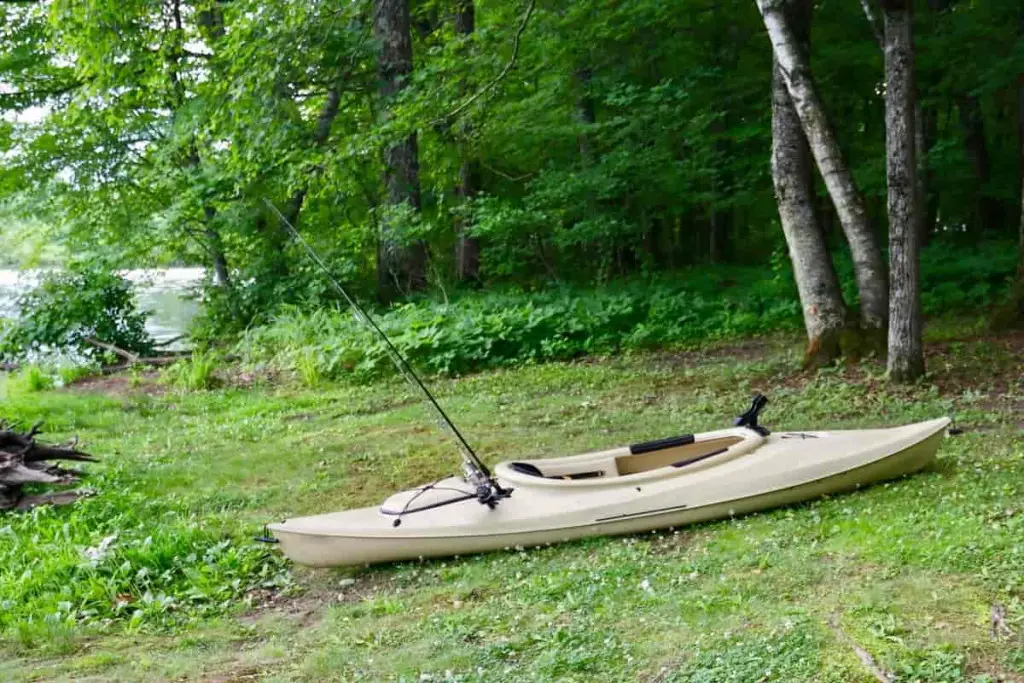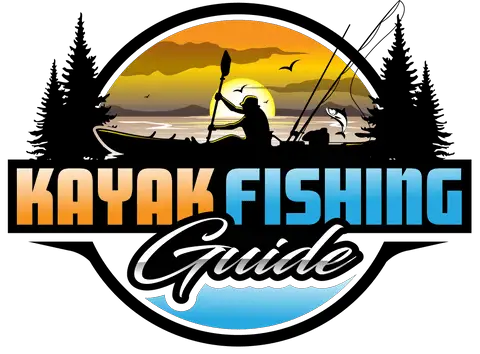
Being blown around by the wind or breeze when sitting in a kayak while trying to fish a rock point, brush pile, or submerged hump can be very frustrating! But is a kayak anchor your only solution?
Kayak anchors are a common way of securing your kayak but are not always needed when fishing. Kayak anchor systems are a good choice when fishing deeper waters. Drift socks can be used in deep water too. Better options to anchor your kayak in shallow waters include stakeout poles or brush grippers.
Many people believe an anchor is the only option for holding your kayak in place! But as you can see above, it isn’t the only option you have!
So read on and let’s dive into this a little deeper!
How Do You Anchor a Kayak?
Whether you’re just beginning your kayak fishing adventures or a seasoned pro, you are going to want to anchor or secure your kayak at some point.
Kayaks can be anchored in numerous ways:
- You can use a grapple or mushroom anchor.
- Many companies make stakeout poles, or you can DIY one for yourself.
- Brush grippers are often used on rivers and small lakes.
- Power poles, although expensive, are gaining in popularity too!
- In the ocean and deep lakes, drift socks are often your best choice.
People have anchored kayaks in many ways. I have even seen anchors made from plastic milk jugs and coffee cans filled with cement! Occasionally, you’ll see someone drop over a cinder block with a rope attached!
Which Kayak Anchoring System for You
Your choice of anchoring systems will mainly depend upon where and what you are fishing for most of the time! Not all anchoring systems are created equal!
Let’s quickly review the different ways to secure or control your kayak!
Anchor Trolley System
An anchor trolley system includes an anchor, two or more cleats, anchor float, and necessary hardware to allow you to move the anchor back and forth from bow to stern. This system allows you to change your anchor point and keep your kayak positioned in one spot safely in winds or currents.
YakAttack Leverloc Anchor Trolley
The YakAttack LeverLoc Anchor Trolley is a must-have for kayak anglers. It allows you to position your anchor precisely for the best fishing spot. Its smooth sliding system and secure locking mechanism let you easily adjust your anchor point and stay steady in any water condition.
The trolley is positioned along the kayak’s length and can maneuver the anchor ring next to your seat for easy release. More advanced kayak fishermen will use a trolley system on both sides of their kayaks!
If you want to know more about anchor trolleys, give my other article How Does a Kayak Anchor Trolley Work? a quick look!
Drift Socks
Drift socks are placed into the water and drag along behind you while the wind pushes your kayak across the water. They significantly slow down your drift rate!
24″ Kayak Drift Sock
The Drift Sock Anchor is essential for kayak anglers who want to control their drift in windy or strong current conditions. It acts like a parachute in the water, slowing your movement and keeping you in the perfect position to fish without drifting away.
Drift socks are best when casting along a shoreline or out on the ocean in a strong breeze. A drift sock will slow you down if the wind moves you too fast to fish the structure efficiently!
Stakeout Poles
A kayak stakeout pole is designed for shallow waters. It is a long stick and much easier and quicker to use than a traditional anchor. The stakeout pole can be placed through an anchor trolley ring or a scupper hole and anchored into the lake’s bottom.
YakGear Floating Stake-Out Pole
The YakGear Floating Stake-Out Pole is perfect for kayak anglers who want a simple and effective way to anchor in shallow waters. This lightweight pole easily stakes into the bottom and floats if dropped, keeping you securely in place while you focus on fishing.
Another method of using a stakeout pole is to place it in the lake or river bottom and tie it off with a small length of rope.
Another option is to build a Do It Yourself stakeout pole! Quite a few yakkers like to build their own kayak projects when they are not on the water!
Whichever way you go, buy or DIY, a stakeout pole can be handy! Warding off a snake swimming your way with a stakeout pole is much cheaper than damaging a $400 carbon kayak paddle!
Brush Grippers
Brush Grippers are about the simplest way to secure your kayak to a dock, brush pile, or just about any stationary object. They can be used in both deep or shallow water!
Brush Gripper Kayak Anchor
The Brush Gripper Kayak Anchor is a fantastic tool for kayak anglers, designed to securely grip onto branches, bushes, or other natural anchors. Its easy-to-use clamp system provides a firm hold, keeping your kayak steady in various conditions so you can fish without drifting.
Just tie the rope off to a cleat on your kayak and attach the brush gripper! You can let out as much line as you want or tie off as short as you like. Brush Grippers are one of the most inexpensive ways to hold your kayak in one spot!
Power Pole
The state of the art anchoring system is the Power Pole Micro Anchor! If you’re primarily fishing on streams and small rivers than this may be the thing for you!
Power-Pole Micro Anchor
The Power-Pole Micro Anchor is a top-notch choice for kayak anglers seeking quick and secure anchoring. This compact, electric anchor deploys at the push of a button, holding your kayak firmly in place in shallow waters, allowing you to fish without worrying about drifting.
With the Power Pole, you can be silently drifting downstream and, at a moment’s notice, hit the button on the control fob and lower the pole remotely with the touch of a finger!
The unit can be hooked into an existing onboard battery system and mounted at the kayak stern. If you don’t have a battery in your kayak, a separate battery and charger can be purchased.
Related Article: How to Outfit a Kayak for Fishing: The Ultimate Guide
So, You Really Don’t Need an Anchor!
With all the options out there and the many different kayak fishing methods and environments, you really don’t need an anchor!
When you have an anchor, a bunch of rope, and possibly a float, you need storage space for all of it. Otherwise, the rope may become entangled in your yak or wrap around your feet!
If you choose an anchor for your kayak, make sure you have the proper amount of line. How Long Should a Kayak Anchor Line Be is definitely a must-read for you!
Now, you, and most people, certainly go with anchors, so let’s take a quick look at anchors and hopefully answer any questions you may have!
How Heavy of an Anchor Do I Need?
On average, a kayak anchor is no lighter than 1lb and generally never heavier than 5lbs. Folding anchors can be lighter since the anchor has more holding power. Mushroom anchors are typically heavier since they have less holding power than their counterparts.
Larger, heavier anchors can damage the lake, river, or ocean bottom, so keep this in mind when choosing an anchor.
Where Do You Put the Anchor on a Kayak?
You’ll want the anchor to be within easy reach of your seat so you can deploy it with the least amount of risk to you and your kayak, if at all possible. You’ll find the best places, either alongside or just behind your kayak’s seat.
When fishing from a sit-in kayak, your options are minimal. You’ll have to place the anchor up in front of you and try to keep your feet from becoming entangled.
When throwing the anchor out, and tying it off on a cleat, keep in mind the stability of your kayak! It’s easy to tip over and capsize, leaning to the side of your yak. How Stable Is a Fishing Kayak? is a top article on Kayak Fishing Guide regarding kayak stability.
Is an Anchor Trolley Necessary?
No, an anchor trolley isn’t necessary, but it makes handling an anchor easier!
You have more anchor adjustability from your sitting position, the options of moving your anchor points to the bow or stern of your kayak, and the ease of deploying or cutting off from your anchor at will.
To learn more about anchor trolleys and if it might be something you’d like, click my article, How Does a Kayak Anchor Trolley Work?
I would certainly recommend a kayak anchor trolley system for your fishing kayak. I run a trolley system with a 3lb anchor on my kayak and use the stakeout pole when applicable.
But whichever way you choose to go or use more than one option, a kayak anchor isn’t always needed with all the options you have to choose from!
Have fun, and stay safe out there!





